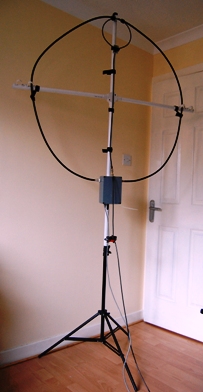The Small Do It Yourself Automatic Tune Magnetic Loop Antenna that he made is only 1 meter in diameter yet it has more or less the performance of a full size dipole – and has an amazing control box.
Magnetic Loops are easy in concept but like many things, you can either make a super-deluxe version with automatic controllers or just keep it simple.
The version presented here is portable, and has a fully automatic tuning system that links to the CAT port of an FT-817.
A single press of a button initiates a tuning sequence and that’s all that is needed to get this antenna on frequency.
For an antenna that is one meter across, standing 1.5 meters above ground this is a formidable result. You’re going to be 2 s-points down on a doublet/dipole on 40m but if you’re operating from a hotel balcony, portable in the countryside or just at home where normal antennas are not allowed, it is not just a compromise antenna, it is a real antenna.
Check out the full story at http://www.gm4wzg.co.uk/antennas.html



